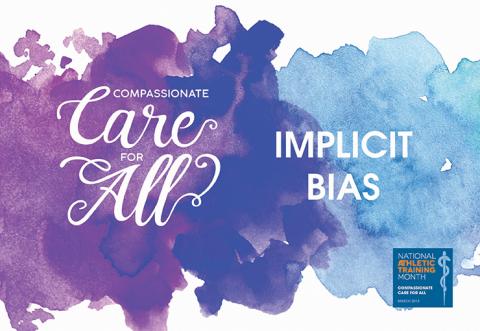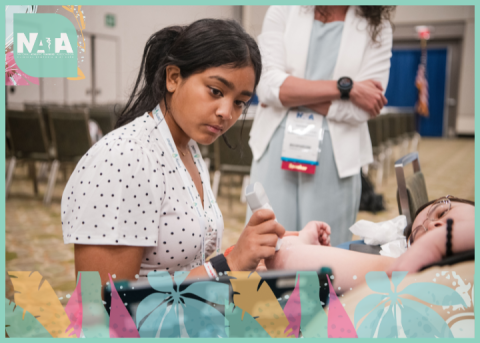
From the editor: This blog is part of the weekly series we’re running during National Athletic Training Month to highlight different aspects athletic trainers should consider as they strive to provide “compassionate care for all.”
ATs work closely with patients from all walks of life, so it is imperative to have a thorough understanding of how patient values such as gender, ethnicity, socioeconomic status, religion, etc. can affect the delivery of appropriate health care. The NATA Cultural Competence Work Group, a collaborative effort between members of the NATA Ethnic Diversity Advisory Committee, LGBTQ+ Committee and the NATA Executive Committee for Education along with members from the Professional Education Committee and Professional Development Committee, was established to look more closely at this topic and provide additional resources as culturally competent care continues to evolve. The workgroup collaborated together on this content series for the March 2018 NATA News and NATA Now examining religion, implicit bias, socioeconomic status and compassionate language.
By Emma Nye, DAT, LAT, ATC, and Mimi Nakajima, EdD, ATC
As a patient, you do not expect to receive a lower standard of care when walking into a doctor’s office because of your race, age, gender or any other characteristic. The same is true when a patient walks into the athletic training facility seeking medical guidance from his/her athletic trainer. As athletic trainers, we abide by the NATA Code of Ethics, 1.1 Members shall render quality patient care regardless of the patient’s race, religion, age, sex, ethnic or national origin, disability, health status, socioeconomic status, sexual orientation, or gender identity.
Although we can agree that ATs have their patients’ best interest at heart, what if we have biases about patients of certain genders, ethnicities or cultures that we may not even recognize is affecting our approach to evaluation? Implicit bias can affect a caregiver’s judgements about his/her patient, resulting in preconceptions as soon as they walk into the health care facility. This blog will explore implicit bias and what it may look like in the athletic training setting. We’ll discuss how to evaluate if you have implicit biases, to what extent these biases exit in health care, and how they may lead to health care disparities in vulnerable patient populations.
Bias is defined as the negative evaluation of one group and its members relative to another.1 Explicit bias requires that a person is aware of his/her evaluation of a group and believes that evaluation is accurate. In contrast, implicit (unconscious) bias does not require an individual to be aware of their evaluations of a certain group and operates in an unintentional and unconscious form.1
In recent years, the theory that implicit bias in health care may directly lead to health care disparities has been well documented in the literature and has received national attention, including highlights in Healthy People 2000 and Healthy People 2010.2 The National Institute of Health has prioritized eliminating health care disparities in its top five initiatives and has encouraged health care practitioners to consider how biases, stereotypes and discrimination may contribute to such disparities.1
Similarly, in 2003, the Institute of Medicine concluded that unrecognized or unknown biases of members of a certain social demographic may affect communication and the care offered to those individuals.1 In an effort to reduce health care disparities, health care professionals must be aware of these implicit biases, as they may directly affect the care provided to specific vulnerable populations2:
- Minority ethnic populations
- Immigrants
- The poor
- Low health-literacy individuals
- Sexual minorities
- Children
- Women
- The elderly
- The mentally ill
- The overweight
- The disabled
Specifically for the LGBTQ+ patient population, there is an overwhelming body of evidence that discriminatory treatment exists to those seeking medical care. In recent years, the notion that implicit bias may play a role in these discriminatory trends has been explored in greater detail. A study published in 2015 revealed heterosexual health care professionals had a moderate to strong preference for treating heterosexual people over gay and lesbian patients.3 With the expansion of athletic training into more diverse clinical settings comes an increase in the diversity of the patient population we treat. As such, athletic trainers must be not only cognizant of their own implicit biases but also knowledgeable about ways to combat such preconceptions to ensure we are providing the best possible health care to our patients.
Here are some additional examples of how implicit bias exists in healthcare4:
- Non-white patients receive fewer cardiovascular interventions.
- Black women are more likely to die after being diagnosed with breast cancer.
- Patients of color are more likely to be blamed for being passive with their health care.
Examine Your Own Biases
One of the important steps in combating such trends is our willingness to examine our own possible biases. Have you ever made an assumption about a patient based on his/her appearance or other basic traits? As humans, our ability to distinguish friends from foe helped us survive, thus we quickly and automatically categorize people based on social or other demographic characteristics. However, we also know this is the foundation of stereotypes, prejudice and ultimately, discrimination.
There are many tools you can use to examine your own possible biases. One tool is the Implicit Association Test (IAT) that measures attitudes and beliefs that people may be unwilling or unable to report. The IAT measures relationships between different concepts (e.g., gender, ethnicity) and your subconscious assessment (e.g., good/bad). Many different IAT are available, including those for gender, ethnicity, sexuality and more. Although the IAT is subject to controversy due to the lack of reproducibility and the question of what it measures, it gives a glimpse to what we may be closing our eyes to.
As I was taking the IAT test, I was very aware that I was avoiding being biased. Instead of using a “split-decision click” like I was supposed to, I took just a bit longer to think through and categorize the target concept. As a person and as a clinician/educator, I think I am very conscious of the biases I am “not supposed to have.” I know that I shouldn’t think an African-American athlete was non-compliant because he was “lazy” but that he may have had transportation issues. I know I shouldn’t use certain language like “You’re gay” because it’s hurtful.
I know all of that, so I don’t do them. But because I know, that is the problem. I know biases are wrong, so I avoid them. You may know all of the biases to avoid, but unless we start facing unconscious biases, we will never be able to honestly tackle the bias within ourselves.
Who am I kidding? I see a parent at the park constantly on their smart phone and judge them for not “being in the moment” with their kids. I see a person driving only 60 miles per hour in the fast lane and shake my head when I see an elderly woman driving. I go to a kid’s birthday party and am surprised when I am introduced to the dad’s husband. These are all biases (preconceived notions) that I have within me that come to surface for a split second. Of course I know I am not supposed to have these biases, so they quickly go away. But just because I was able to get rid of them doesn’t mean I don’t have them. That is probably why, when taking the IAT test, I was keenly aware that I was afraid of finding my implicit bias.
As mentioned above, examining one’s own biases is the first step of combating the biases within our society and within health care. I hope those of you reading this blog will take an IAT test (or any test that examines your implicit bias) and try to answer honestly instead of focusing on answering “correctly.” Because putting the bias out in the open is the first step in eliminating it. Hiding it does not solve any problems.
A major project on the IATs resulted in several key findings4:
- Implicit bias is pervasive
- People are often unaware of their implicit bias
- Implicit bias predicts behavior
- People differ in levels of implicit bias
Once these biases are identified, health care providers should seek out resources, strategies and skills to prevent unconscious attitudes and stereotypes from influencing the course of treatment.
Strategies to better care for patients of diverse backgrounds:
- Focus on individual attributes of each patient, rather than seeing the patient through a lens of group membership
- Enhance communication by interacting and discussing with colleagues and patients with diverse experiences
- Increase perspective taking and empathy
How can I fight biases and stereotyping?
- Point it out. Be the person who points out negative preconceptions and openly talks about it.
- Be an example. Be a role model and respect people regardless of what society says about them.
- Speak up. Challenge those around you to reflect and engage in open conversations.
Read more about cultural competence in athletic training.
References
-
Blair IV, Steiner JF, Havranek EP. Unconscious (Implicit) Bias and health disparities: Where do we go from here? Perm J. 2011; 15(2):71-78.
-
FitzGerald C, Hurst S. Implicit bias in healthcare professionals: A systematic review. BMC Med Ethics. 2017;18:19.
-
Sabin J, Riskind RG, Nosek BA. Health care providers’ implicit and explicit attitudes towards lesbian and gay men. American Journal of Public Health. 2015;105(9), 1831-1841.
-
Implicit bias in healthcare. Quick Safety. The Joint Commission. April 2016; 23.





